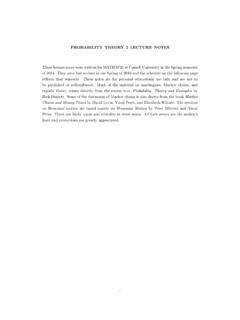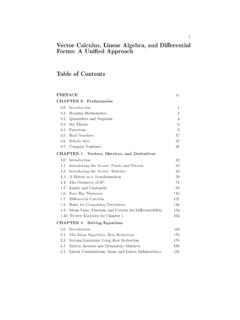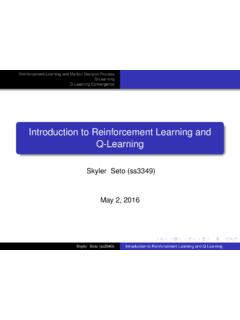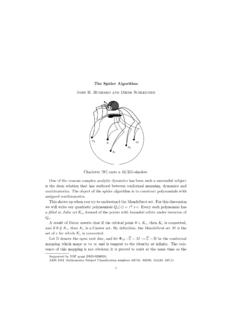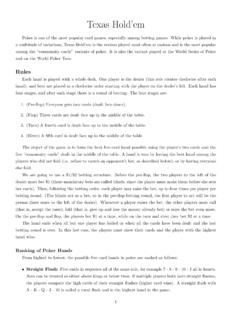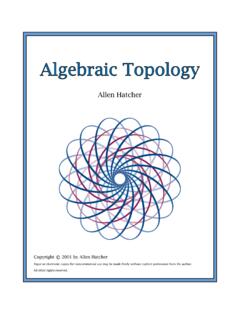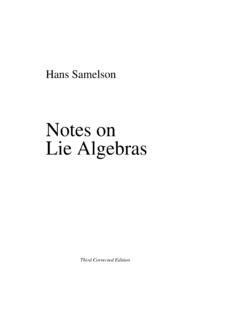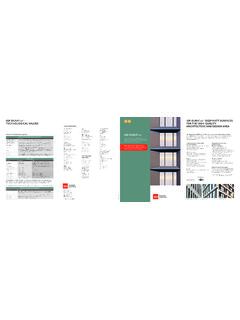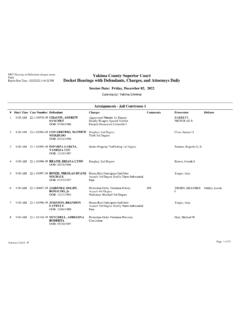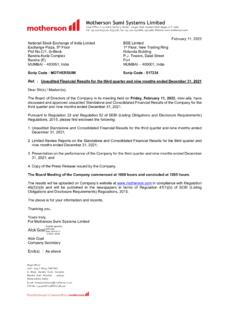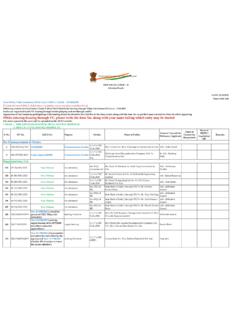Transcription of Preface - pi.math.cornell.edu
1 Preface .. ixStandard Notations 0. Some Underlying Geometric Notions.. 1 Homotopy and Homotopy Type 1. Cell Complexes on Spaces 8. Two Criteria for Homotopy Equivalence Homotopy Extension Property 1. The Fundamental Group.. Basic Constructions.. 25 Paths and Homotopy 25. The Fundamental Group of the Circle Homomorphisms Van Kampen s Theorem.. 40 Free Products of Groups 41. The van Kampen Theorem to Cell Complexes Covering Spaces.. 56 Lifting Properties 60. The Classification of Covering Spaces Transformations and Group Actions Graphs and Free Groups K(G,1) Spaces and Graphs of Groups 2. Homology.. Simplicial and Singular Homology.. 102 Complexes 102. Simplicial Homology 104. Singular Invariance 110. Exact Sequences and Excision Equivalence of Simplicial and Singular Homology Computations and Applications.. 134 Degree 134. Cellular Homology 137. Mayer-Vietoris Sequences with Coefficients The Formal Viewpoint.
2 160 Axioms for Homology 160. Categories and Functors Homology and Fundamental Group Classical Applications Simplicial Approximation 3. Cohomology.. Cohomology Groups.. 190 The Universal Coefficient Theorem 190. Cohomology of Spaces Cup Product.. 206 The Cohomology Ring 212. A K unneth Formula with Polynomial Cohomology Poincar e Duality.. 230 Orientations and Homology 233. The Duality Theorem with Cup Product 249. Other Forms of Duality Universal Coefficients for Homology The General K unneth Formula H Spaces and Hopf Algebras The Cohomology of SO(n) Bockstein Homomorphisms Limits and Ext Transfer Homomorphisms Local Coefficients 4. Homotopy Theory.. Homotopy Groups.. 339 Definitions and Basic Constructions 340. Whitehead s Theorem Approximation 348. CW Approximation Elementary Methods of Calculation.. 360 Excision for Homotopy Groups 360. The Hurewicz Theorem Bundles 375. Stable Homotopy Groups Connections with Cohomology.
3 393 The Homotopy Construction of Cohomology 393. Fibrations Towers 410. Obstruction Theory Basepoints and Homotopy The Hopf Invariant Minimal Cell Structures Cohomology of Fiber Bundles The Brown Representability Theorem Spectra and Homology Theories Gluing Constructions Eckmann-Hilton Duality Stable Splittings of Spaces The Loopspace of a Suspension The Dold-Thom Theorem Steenrod Squares and Powers .. 519 Topology of Cell Complexes 519. The Compact-Open Topology Homotopy Extension Property 533. Simplicial CW Structures .. 540 Index.. 546 This book was written to be a readable introduction to algebraic topology withrather broad coverage of the subject. The viewpoint is quiteclassical in spirit, andstays well within the confines of pure algebraic topology. Ina sense, the book couldhave been written thirty or forty years ago since virtually everything in it is at leastthat old. However, the passage of the intervening years has helped clarify what arethe most important results and techniques.
4 For example, CW complexes have provedover time to be the most natural class of spaces for algebraictopology, so they areemphasized here much more than in the books of an earlier generation. This empha-sis also illustrates the book s general slant towards geometric, rather than algebraic,aspects of the subject. The geometry of algebraic topology is so pretty, it would seema pity to slight it and to miss all the intuition it the elementary level, algebraic topology separates naturally into the two broadchannels of homology and homotopy. This material is here divided into four chap-ters, roughly according to increasing sophistication, with homotopy split betweenChapters 1 and 4, and homology and its mirror variant cohomology in Chapters 2and 3. These four chapters do not have to be read in this order,however. One couldbegin with homology and perhaps continue with cohomology before turning to ho-motopy. In the other direction, one could postpone homologyand cohomology untilafter parts of Chapter 4.
5 If this latter strategy is pushed toits natural limit, homologyand cohomology can be developed just as branches of homotopytheory. Appealingas this approach is from a strictly logical point of view, it places more demands on thereader, and since readability is one of the first priorities of the book, this homotopicinterpretation of homology and cohomology is described only after the latter theorieshave been developed independently of homotopy the four main chapters there is a preliminary Chapter 0 introducingsome of the basic geometric concepts and constructions thatplay a central role inboth the homological and homotopical sides of the subject. This can either be readbefore the other chapters or skipped and referred back to later for specific topics asthey become needed in the subsequent of the four main chapters concludes with a selection of additional topics thatthe reader can sample at will, independent of the basic core of the book contained inthe earlier parts of the chapters.
6 Many of these extra topicsare in fact rather importantin the overall scheme of algebraic topology, though they might not fit into the timexPrefaceconstraints of a first course. Altogether, these additionaltopics amount to nearly halfthe book, and they are included here both to make the book morecomprehensive andto give the reader who takes the time to delve into them a more substantial sample ofthe true richness and beauty of the is also an Appendix dealing mainly with a number of matters of a point-set topological nature that arise in algebraic topology. Since this is a textbook onalgebraic topology, details involving point-set topologyare often treated lightly orskipped entirely in the body of the included in this book is the important but somewhat more sophisticatedtopic of spectral sequences. It was very tempting to includesomething about thismarvelous tool here, but spectral sequences are such a big topic that it seemed bestto start with them afresh in a new volume.
7 This is tentativelytitled Spectral Sequencesin Algebraic Topology and is referred to herein as [SSAT]. There is also a third book inprogress, on vector bundles, characteristic classes, and K theory, which will be largelyindependent of [SSAT] and also of much of the present book. This is referred to as[VBKT], its provisional title being Vector Bundles and K Theory .In terms of prerequisites, the present book assumes the reader has some familiar-ity with the content of the standard undergraduate courses in algebra and point-settopology. In particular, the reader should know about quotient spaces, or identifi-cation spaces as they are sometimes called, which are quite important for algebraictopology. Good sources for this concept are the textbooks [Armstrong 1983] and[J anich 1984] listed in the book such as this one, whose aim is to present classical material from a ratherclassical viewpoint, is not the place to indulge in wild innovation.
8 There is, however,one small novelty in the exposition that may be worth commenting upon, even thoughin the book as a whole it plays a relatively minor role. This isthe use of what we call complexes, which are a mild generalization of the classicalnotion of a simplicialcomplex. The idea is to decompose a space into simplices allowing different facesof a simplex to coincide and dropping the requirement that simplices are uniquelydetermined by their vertices. For example, if one takes the standard picture of thetorus as a square with opposite edges identified and divides the square into two tri-angles by cutting along a diagonal, then the result is a complex structure on thetorus having 2 triangles, 3 edges, and 1 vertex. By contrast,a simplicial complexstructure on the torus must have at least 14 triangles, 21 edges, and 7 vertices. So complexes provide a significant improvement in efficiency, which is nice from a ped-agogical viewpoint since it simplifies calculations in examples.
9 A more fundamentalreason for considering complexes is that they seem to be very natural objects fromthe viewpoint of algebraic topology. They are the natural domain of definition forsimplicial homology, and a number of standard constructions produce complexesrather than simplicial complexes. Historically, complexes were first introduced byPrefacexiEilenberg and Zilber in 1950 under the name of semisimplicial complexes. Soon afterthis, additional structure in the form of certain degeneracy maps was introduced,leading to a very useful class of objects that came to be called simplicial sets. Thesemisimplicial complexes of Eilenberg and Zilber then became semisimplicial sets ,but in this book we have chosen to use the shorter term complex .This book will remain available online in electronic form after it has been printedin the traditional fashion. The web address hatcherOne can also find here the parts of the other two books in the sequence that arecurrently available.
10 Although the present book has gone through countless revisions,including the correction of many small errors both typographical and mathematicalfound by careful readers of earlier versions, it is inevitable that some errors remain, sothe web page includes a list of corrections to the printed version. With the electronicversion of the book it will be possible not only to incorporate corrections but alsoto make more substantial revisions and additions. Readers are encouraged to sendcomments and suggestions as well as corrections to the emailaddress posted on theweb on the 2015 large number of corrections are included in thisreprinting. In addition there are two places in the book where the material was re-arranged to an extent requiring renumbering of theorems, etc. In starting onpage 210 the renumbering is the in the following renumbering occurs in pages 352 355 NotationsZ,Q,R,C,H,O: the integers, rationals, reals, complexes, quaternions,and : the integers :ndimensional Euclidean : particular,R0= {0}=C0, zero-dimensional vector [0,1]: the unit : the unit sphere inRn+1, all points of distance 1 from the : the unit disk or ball inRn, all points of distance 1 from the origin.

